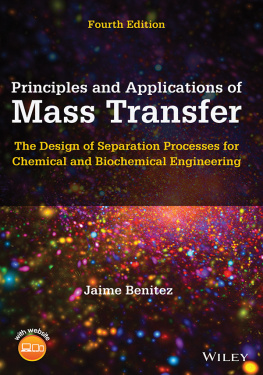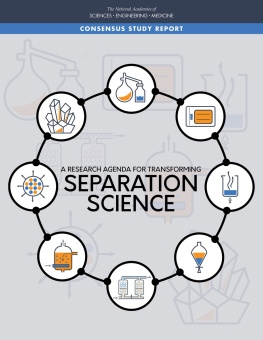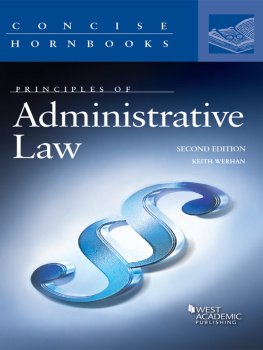Christie John Geankoplis - Transport Processes and Separation Process Principles
Here you can read online Christie John Geankoplis - Transport Processes and Separation Process Principles full text of the book (entire story) in english for free. Download pdf and epub, get meaning, cover and reviews about this ebook. year: 2018, publisher: Prentice Hall, genre: Children. Description of the work, (preface) as well as reviews are available. Best literature library LitArk.com created for fans of good reading and offers a wide selection of genres:
Romance novel
Science fiction
Adventure
Detective
Science
History
Home and family
Prose
Art
Politics
Computer
Non-fiction
Religion
Business
Children
Humor
Choose a favorite category and find really read worthwhile books. Enjoy immersion in the world of imagination, feel the emotions of the characters or learn something new for yourself, make an fascinating discovery.

- Book:Transport Processes and Separation Process Principles
- Author:
- Publisher:Prentice Hall
- Genre:
- Year:2018
- Rating:4 / 5
- Favourites:Add to favourites
- Your mark:
- 80
- 1
- 2
- 3
- 4
- 5
Transport Processes and Separation Process Principles: summary, description and annotation
We offer to read an annotation, description, summary or preface (depends on what the author of the book "Transport Processes and Separation Process Principles" wrote himself). If you haven't found the necessary information about the book — write in the comments, we will try to find it.
Transport Processes and Separation Process Principles — read online for free the complete book (whole text) full work
Below is the text of the book, divided by pages. System saving the place of the last page read, allows you to conveniently read the book "Transport Processes and Separation Process Principles" online for free, without having to search again every time where you left off. Put a bookmark, and you can go to the page where you finished reading at any time.
Font size:
Interval:
Bookmark:

EPUB is an open, industry-standard format for e-books. However, support for EPUB and its many features varies across reading devices and applications. Use your device or app settings to customize the presentation to your liking. Settings that you can customize often include font, font size, single or double column, landscape or portrait mode, and figures that you can click or tap to enlarge. For additional information about the settings and features on your reading device or app, visit the device manufacturers Web site.
Many titles include programming code or configuration examples. To optimize the presentation of these elements, view the e-book in single-column, landscape mode and adjust the font size to the smallest setting. In addition to presenting code and configurations in the reflowable text format, we have included images of the code that mimic the presentation found in the print book; therefore, where the reflowable format may compromise the presentation of the code listing, you will see a Click here to view code image link. Click the link to view the print-fidelity code image. To return to the previous page viewed, click the Back button on your device or app.
Transport Processes and Separation Process Principles
Fifth Edition
Fifth Edition
CHRISTIE JOHN GEANKOPLIS
A. ALLEN HERSEL
DANIEL H. LEPEK

Many of the designations used by manufacturers and sellers to distinguish their products are claimed as trademarks. Where those designations appear in this book, and the publisher was aware of a trademark claim, the designations have been printed with initial capital letters or in all capitals.
The authors and publisher have taken care in the preparation of this book, but make no expressed or implied warranty of any kind and assume no responsibility for errors or omissions. No liability is assumed for incidental or consequential damages in connection with or arising out of the use of the information or programs contained herein.
For information about buying this title in bulk quantities, or for special sales opportunities (which may include electronic versions; custom cover designs; and content particular to your business, training goals, marketing focus, or branding interests), please contact our corporate sales department at or (800) 382-3419.
For government sales inquiries, please contact .
For questions about sales outside the U.S., please contact .
Visit us on the Web: informit.com
Library of Congress Control Number: 2017956182
Copyright 2018 Pearson Education, Inc.
All rights reserved. Printed in the United States of America. This publication is protected by copyright, and permission must be obtained from the publisher prior to any prohibited reproduction, storage in a retrieval system, or transmission in any form or by any means, electronic, mechanical, photocopying, recording, or likewise. For information regarding permissions, request forms and the appropriate contacts within the Pearson Education Global Rights & Permissions Department, please visit www.pearsoned.com/permissions/.
ISBN-13: 978-0-13-418102-8
ISBN-10: 0-13-418102-6
1 18
To my mom, my wife, and my three sons
Allen
To my family, friends, and the many students that I have taught
Daniel
PART 1
TRANSPORT PROCESSES: MOMENTUM, HEAT, AND MASS
PART 2
SEPARATION PROCESS PRINCIPLES
PART 3
APPENDIXES
In this updated fifth edition of Transport Processes and Separation Process Principles, the main objective was to reorganize the text into a new format that resembles contemporary transport phenomena and separations texts. Due to this overhaul, the total number of chapters has been increased from 14 to 33. Our hope is that the readability and the usage of the text have been improved for student learning. In addition, we have created numerous new homework problems, which can be found on our companion website (https://www.trine.edu/transport5ed/). Due to the prior widespread adoption of previous editions of the text, we made small changes to the content of the fifth edition of the text so that many more readers could adapt to the new format.
Since chemical and other engineering students must study many different topics today, we have provided a more unified introduction to the transport processes of momentum, heat, and mass transfer, and to the application of separation processes. In this text, the principles of transport processes are covered first, and then the separation processes (unit operations) are covered later. To accomplish this, the text is divided into two major parts.
This first part of the text deals with the fundamental principles of transport phenomena.
Fluid Mechanics: 1. Introduction to Engineering Principles and Units; 2. Introduction to Fluids and Fluid Statics; 3. Fluid Properties and Fluid Flows; 4. Overall Mass, Energy, and Momentum Balances; 5. Incompressible and Compressible Flows in Pipes; 6. Flows in Packed and Fluidized Beds; 7. Pumps, Compressors, and Agitation Equipment; 8. Differential Equations of Fluid Flow; 9. Non-Newtonian Fluids; 10. Potential Flow and Creeping Flow; 11. Boundary-Layer and Turbulent Flow.
Heat Transfer: 12. Introduction to Heat Transfer; 13. Steady-State Conduction; 14. Principles of Unsteady-State Heat Transfer; 15. Introduction to Convection; 16. Heat Exchangers; 17. Introduction to Radiation Heat Transfer.
Mass Transfer: 18. Introduction to Mass Transfer; 19. Steady-State Mass Transfer; 20. Unsteady-State Mass Transfer; 21. Convective Mass Transfer.
This part of the text deals with applications of transport processes and covers separation processes in the following chapters: 22. Absorption and Stripping; 23. Humidification Processes; 24. Filtration and Membrane Separation Processes (LiquidLiquid or SolidLiquid Phase); 25. Gaseous Membrane Systems; 26. Distillation; 27. LiquidLiquid Extraction; 28. Adsorption and Ion Exchange; 29. Crystallization and Particle Size Reduction; 30. Settling, Sedimentation, and Centrifugation; 31. Leaching; 32. Evaporation; 33. Drying.
In , elementary principles of mathematical and graphical methods, laws of chemistry and physics, material balances, and heat balances are reviewed. Many readers, especially chemical engineers, may be familiar with most of these principles, and may omit all or parts of the chapter.
This text may be used for a course of study that follows any of the five suggested plans noted below. In all plans, the inclusion of is optional.
1. Study of transport processes of momentum, heat, and mass, and separation processes. In this plan, most of the text covers the principles of the transport processes in . This plan would be applicable primarily to chemical engineering as well as to other process-engineering fields in a one-and-one-half-year course of study at the junior and/or senior level.
2. Study of transport processes of momentum, heat, and mass, and selected separation processes
Font size:
Interval:
Bookmark:
Similar books «Transport Processes and Separation Process Principles»
Look at similar books to Transport Processes and Separation Process Principles. We have selected literature similar in name and meaning in the hope of providing readers with more options to find new, interesting, not yet read works.
Discussion, reviews of the book Transport Processes and Separation Process Principles and just readers' own opinions. Leave your comments, write what you think about the work, its meaning or the main characters. Specify what exactly you liked and what you didn't like, and why you think so.










